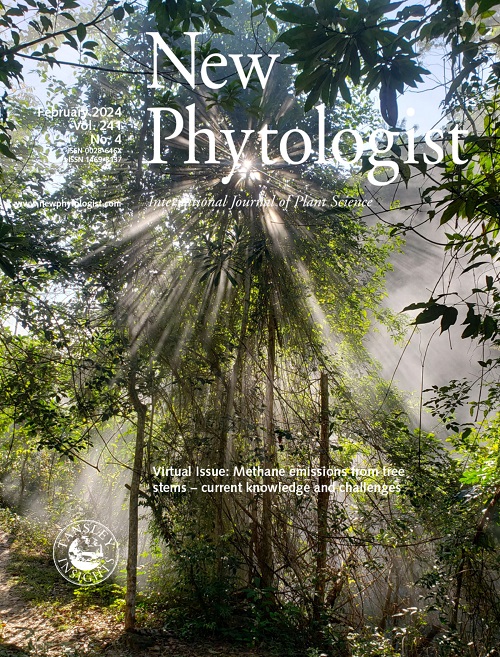大豆免疫受体GmBIR1在囊肿线虫感染过程中调节宿主转录组、剪接体和免疫
IF 8.1
1区 生物学
Q1 Agricultural and Biological Sciences
引用次数: 0
摘要
bak1 -相互作用受体如KINASE1 (BIR1)是疾病抵抗和免疫反应各方面的负调控因子。本文研究了大豆(Glycine max) BIR1 (GmBIR1)在大豆与大豆囊线虫(Heterodera glycines, SCN)相互作用中的功能作用,以及GmBIR1调控植物免疫的分子机制。利用转基因大豆毛状根过表达GmBIR1野生型变异(WT-GmBIR1)可显著提高大豆对SCN的敏感性,而过表达激酶死亡变异(KD-GmBIR1)可显著提高植物对SCN的抗性。转录组分析显示,在SCN感染时,WT-GmBIR1和KD-GmBIR1中反向调控的基因主要富集于防御和免疫相关功能。定量磷酸化蛋白质组学分析鉴定出208个蛋白可能是GmBIR1信号通路的底物,其中114个蛋白在SCN感染时发生差异磷酸化。此外,磷酸化蛋白质组学数据指出GmBIR1信号通路在调节备选pre-mRNA剪接中的作用。对剪接事件的全基因组分析提供了令人信服的证据,支持GmBIR1信号通路在SCN感染期间建立选择性剪接中的作用。我们的研究结果为GmBIR1信号通路通过剪接因子的差异磷酸化和pre-mRNA衰变和剪接体相关基因的剪接事件调控大豆转录组和剪接体的功能提供了新的机制见解。本文章由计算机程序翻译,如有差异,请以英文原文为准。
The soybean immune receptor GmBIR1 regulates host transcriptome, spliceome, and immunity during cyst nematode infection
- BAK1-INTERACTING RECEPTOR LIKE KINASE1 (BIR1) is a negative regulator of various aspects of disease resistance and immune responses.
- Here, we investigated the functional role of soybean (Glycine max) BIR1 (GmBIR1) during soybean interaction with soybean cyst nematode (SCN, Heterodera glycines) and the molecular mechanism through which GmBIR1 regulates plant immunity.
- Overexpression of wild-type variant of GmBIR1 (WT-GmBIR1) using transgenic soybean hairy roots significantly increased soybean susceptibility to SCN, whereas overexpression of kinase-dead variant (KD-GmBIR1) significantly increased plant resistance. Transcriptome analysis revealed that genes oppositely regulated in WT-GmBIR1 and KD-GmBIR1 upon SCN infection were enriched primarily in defense and immunity-related functions. Quantitative phosphoproteomic analysis identified 208 proteins as putative substrates of the GmBIR1 signaling pathway, 114 of which were differentially phosphorylated upon SCN infection. In addition, the phosphoproteomic data pointed to a role of the GmBIR1 signaling pathway in regulating alternative pre-mRNA splicing. Genome-wide analysis of splicing events provided compelling evidence supporting a role of the GmBIR1 signaling pathway in establishing alternative splicing during SCN infection.
- Our results provide novel mechanistic insights into the function of the GmBIR1 signaling pathway in regulating soybean transcriptome and spliceome via differential phosphorylation of splicing factors and regulation of splicing events of pre-mRNA decay- and spliceosome-related genes.
求助全文
通过发布文献求助,成功后即可免费获取论文全文。
去求助
来源期刊

New Phytologist
PLANT SCIENCES-
CiteScore
17.60
自引率
5.30%
发文量
728
审稿时长
1 months
期刊介绍:
New Phytologist is a leading publication that showcases exceptional and groundbreaking research in plant science and its practical applications. With a focus on five distinct sections - Physiology & Development, Environment, Interaction, Evolution, and Transformative Plant Biotechnology - the journal covers a wide array of topics ranging from cellular processes to the impact of global environmental changes. We encourage the use of interdisciplinary approaches, and our content is structured to reflect this. Our journal acknowledges the diverse techniques employed in plant science, including molecular and cell biology, functional genomics, modeling, and system-based approaches, across various subfields.
 求助内容:
求助内容: 应助结果提醒方式:
应助结果提醒方式:


